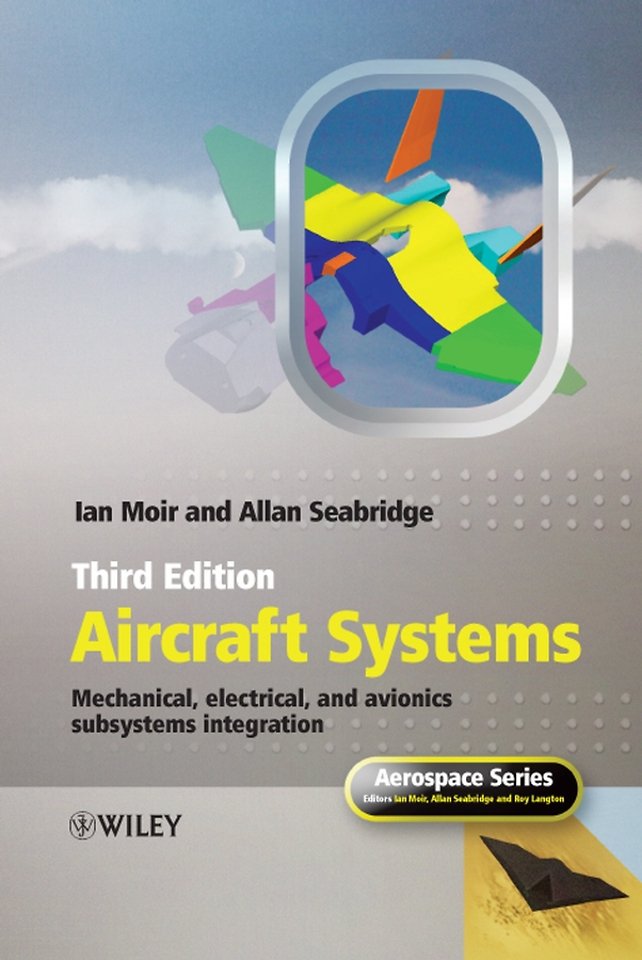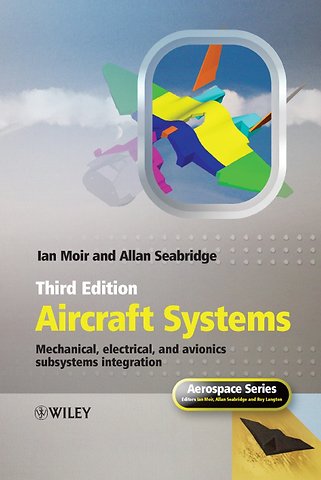Aircraft Systems
Mechanical, Electrical, and Avionics Subsystems Integration
Samenvatting
This third edition of
Aircraft Systems represents a timely update of the Aerospace Series successful and widely acclaimed flagship title. Moir and Seabridge present an in–depth study of the general systems of an aircraft electronics, hydraulics, pneumatics, emergency systems and flight control to name but a few – that transform an aircraft shell into a living, functioning and communicating flying machine. Advances in systems technology continue to alloy systems and avionics, with aircraft support and flight systems increasingly controlled and monitored by electronics; the authors handle the complexities of these overlaps and interactions in a straightforward and accessible manner that also enhances synergy with the book s two sister volumes,
Civil Avionics Systems and
Military Avionics Systems.
Aircraft Systems, 3rd Edition is thoroughly revised and expanded from the last edition in 2001, reflecting the significant technological and procedural changes that have occurred in the interim new aircraft types, increased electronic implementation, developing markets, increased environmental pressures and the emergence of UAVs. Every chapter is updated, and the latest technologies depicted. It offers an essential reference tool for aerospace industry researchers and practitioners such as aircraft designers, fuel specialists, engine specialists, and ground crew maintenance providers, as well as a textbook for senior undergraduate and postgraduate students in systems engineering, aerospace and engineering avionics.
Specificaties
Inhoudsopgave
Series Preface xix
About the Authors xxi
Acknowledgements xxiii
List of Abbreviations xxv
Introduction xxxv
Systems Integration xxxvi
Systems Interaction xxxix
1 Flight Control Systems 1
1.1 Introduction 1
1.2 Principles of Flight Control 3
1.3 Flight Control Surfaces 4
1.4 Primary Flight Control 5
1.5 Secondary Flight Control 5
1.6 Commercial Aircraft 7
1.7 Flight Control Linkage Systems 9
1.8 High Lift Control Systems 13
1.9 Trim and Feel 15
1.10 Flight Control Actuation 18
1.11 Civil System Implementations 34
1.12 Fly–By–Wire Control Laws 40
1.13 A380 Flight Control Actuation 41
1.14 Boeing 777 Implementation 44
1.15 Interrelationship of Flight Control, Guidance and Flight Management 48
2 Engine Control Systems 51
2.1 Introduction 51
2.2 Engine Technology and Principles of Operation 53
2.3 The Control Problem 55
2.4 Example Systems 62
2.5 Design Criteria 71
2.6 Engine Starting 73
2.7 Engine Indications 78
2.8 Engine Oil Systems 81
2.9 Engine Offtakes 81
2.10 Reverse Thrust 83
2.11 Engine Control on Modern Civil Aircraft 84
3 Fuel Systems 87
3.1 Introduction 87
3.2 Characteristics of Fuel Systems 89
3.3 Description of Fuel System Components 90
3.4 Fuel Quantity Measurement 94
3.5 Fuel System Operating Modes 105
3.6 Integrated Civil Aircraft Systems 116
3.7 Fuel Tank Safety 128
3.8 Polar Operations Cold Fuel Management 133
4 Hydraulic Systems 137
4.1 Introduction 137
4.2 Hydraulic Circuit Design 138
4.3 Hydraulic Actuation 142
4.4 Hydraulic Fluid 144
4.5 Fluid Pressure 145
4.6 Fluid Temperature 145
4.7 Fluid Flow Rate 146
4.8 Hydraulic Piping 146
4.9 Hydraulic Pumps 147
4.10 Fluid Conditioning 151
4.11 Hydraulic Reservoir 152
4.12 Warnings and Status 152
4.13 Emergency Power Sources 153
4.14 Proof of Design 154
4.15 Aircraft System Applications 155
4.16 Civil Transport Comparison 163
4.17 Landing Gear Systems 167
5 Electrical Systems 181
5.1 Introduction 181
5.2 Aircraft Electrical System 184
5.3 Power Generation 185
5.4 Primary Power Distribution 199
5.5 Power Conversion and Energy Storage 201
5.6 Secondary Power Distribution 203
5.7 Typical Aircraft DC System 207
5.8 Typical Civil Transport Electrical System 208
5.9 Electrical Loads 210
5.10 Emergency Power Generation 214
5.11 Recent Systems Developments 218
5.12 Recent Electrical System Developments 228
5.13 Electrical Systems Displays 237
6 Pneumatic Systems 239
6.1 Introduction 239
6.2 Use of Bleed Air 240
6.3 Engine Bleed Air Control 244
6.4 Bleed Air System Indications 247
6.5 Bleed Air System Users 247
6.6 Pitot Static Systems 252
7 Environmental Control Systems 259
7.1 Introduction 259
7.2 The Need for a Controlled Environment 260
7.3 The International Standard Atmosphere (ISA) 263
7.4 Environmental Control System Design 266
7.5 Cooling Systems 271
7.6 Humidity Control 278
7.7 The Inefficiency of Present Systems 279
7.8 Air Distribution Systems 279
7.9 Cabin Noise 284
7.10 Cabin Pressurisation 284
7.11 Hypoxia 287
7.12 Molecular Sieve Oxygen Concentrators 288
7.13 g Tolerance 291
7.14 Rain Dispersal 292
7.15 Anti–Misting and De–Misting 293
7.16 Aircraft Icing 293
8 Emergency Systems 297
8.1 Introduction 297
8.2 Warning Systems 298
8.3 Fire Detection and Suppression 301
8.4 Emergency Power Sources 305
8.5 Explosion Suppression 307
8.6 Emergency Oxygen 308
8.7 Passenger Evacuation 308
8.8 Crew Escape 310
8.9 Computer–Controlled Seats 312
8.10 Ejection System Timing 313
8.11 High Speed Escape 314
8.12 Crash Recorder 314
8.13 Crash Switch 315
8.14 Emergency Landing 315
8.15 Emergency System Testing 317
9 Rotary Wing Systems 319
9.1 Introduction 319
9.2 Special Requirements of Helicopters 320
9.3 Principles of Helicopter Flight 321
9.4 Helicopter Flight Control 324
9.5 Primary Flight Control Actuation 325
9.6 Key Helicopter Systems 333
9.7 Helicopter Auto–Flight Control 343
9.8 Active Control Technology 349
9.9 Advanced Battlefield Helicopter 350
9.10 Tilt Rotor Systems 357
10 Advanced Systems 371
10.1 Introduction 371
10.2 Stealth 374
10.3 Integrated Flight and Propulsion Control (IFPC) 375
10.4 Vehicle Management System 377
10.5 More–Electric Aircraft 381
10.6 More–Electric Actuation 388
10.7 More–Electric Engine 389
10.8 Impact of Stealth Design 393
10.9 Technology Developments/Demonstrators 402
11 System Design and Development 407
11.1 Introduction 407
11.2 System Design 408
11.3 Major Safety Processes 411
11.4 Requirements Capture 415
11.5 Fault Tree Analysis (FTA) 418
11.6 Dependency Diagram 420
11.7 Failure Modes and Effects Analysis (FMEA) 422
11.8 Component Reliability 423
11.9 Dispatch Reliability 424
11.10 Markov Analysis 425
11.11 Development Processes 427
11.12 Extended Operations (ETOPS) 438
12 Avionics Technology 441
12.1 Introduction 441
12.2 The Nature of Microelectronic Devices 443
12.3 Data Bus Integration of Aircraft Systems 460
12.4 Fibre Optic Buses 469
12.5 Avionics Packaging Standards 470
12.6 Typical LRU Architecture 471
12.7 Integrated Modular Avionics 473
13 Environmental Conditions 477
13.1 Introduction 477
13.2 Environmental Factors 479
13.3 Testing and Validation Process 493
Index 499









